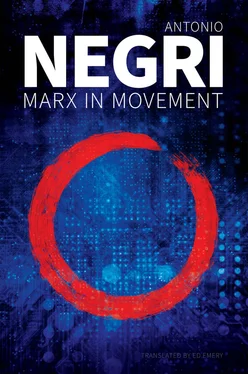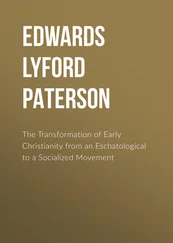In the early 1970s a new phase already opens in workerist research, and it is built around the formidably anticipatory work of Maria Rosa Dalla Costa, Alisa Del Re, and other women comrades working on the issue of reproduction. The movement for wages for housework shifts the analysis from the factory to the home, from male workers to their families, and captures, in the social dimension of exploitation, the specificity of the exploitation suffered by woman – as mother, as daughter, as careworker, as first agent of social reproduction. This is an explosive moment in workerist research. In this way workerism comes to be massively a part of feminism and, in addition to proposing areas for the liberation of women, it builds those mechanisms of research and critique of the patriarchal power that make possible the expansion of the concept of surplus value and exploitation to society as a whole, far beyond the factory. This shift, in turn, makes it possible to widen workerist analysis, extending it from production to reproduction. This then led to a second cluster of studies, accompanied, as always, by experiences of militancy and intervention and exemplified in the work of Luciano Ferrari Bravo, Ferruccio Gambino, Sandro Serafini (and, next, of Karl Heinz Roth and Yann Moulier) on the socialization of living labour and on the mobility of labour power. The radical critique of schemas of reproduction in the light of historical research, the invention of an alternative history of the working class, and the revisiting of slavery and colonialism in the light of the development of capitalism thus come to constitute a new terrain of analysis.
By now we have moved definitively beyond some of the Eurocentric limits of the initial programme of theoretical workerism. From the perspective of the work carried out during these years (moving into the 1980s), the workerist analysis indeed broke with the old socialist classification of economic periods and modes of production, tracing a line of development of capitalism that included colonialism and slavery as determining and internal elements. The critical and subversive analysis of patriarchy had allowed us to view the systemic links of the processes of exploitation and proletarianization ‘through command’ – and, in this context, to tighten the analysis of the production of goods and of the reproduction of forms of command for social exploitation.
A third phase of workerist development began in the 1980s and 1990s, when Christian Marazzi, Paolo Virno, Maurizio Lazzarato and Carlo Vercellone (among others, and with continuous and bold contributions from Sergio Bologna and the journal Primo Maggio ) began to investigate the new technical composition of social labour [ lavoro sociale ], starting from the dissolution of Fordism and the birth of neoliberalism and stressing the monetary and financial mediations in post-Fordism, as well as the combined phenomena of precarization and the cognitive figure of living labour as fundamental elements that characterize the current phase of capitalist development. And then there were the studies of Michael Hardt, Sandro Mezzadra and Brett Neilson on global migration and the international dimension of the class struggle, with multiplications that were now becoming viral.
* * *
It is within this framework that, in this book, I document my own contribution to the development of workerism, and in particular to the transformation represented in the transition from the mass worker to the social worker [ dall’operaio massa all’operaio sociale ]. I would say that, with my work, I have liberated the method and concept of living labour from the dialectical cages that kept it confined to the factory. In fact it should be noted that, even when the inquiries and the practices of struggle testified to the fact that the front of the class struggle had expanded to other figures of living labour that were extraneous to the factory (women in domestic and care work, ethnic minorities crushed at the bottom of the social hierarchy, students and scientific researchers now subjected to the productive order of capitalism, etc.) – and so even when it seemed that the path to a definition of living labour on the social terrain was finally open – people were not able to imagine the independence of a new, living figure of living labour , totally social, whose productive composition was not fixed by belonging to the factory. The reasons for this were an insufficiency of research and a kind of reverential ethical timidity in the face of the glorious tradition of the struggles of factory workers. The situation became more serious when that inability to recognize the new stemmed from a refusal to imagine any ‘technical composition’ of productive labour other than that which the Third International had proposed for the class as ‘political composition’ (perhaps correctly in the case of Leninism, but certainly wrongly in Stalinism). In consequence, even when the technical composition of Fordism had come to an end, had exhausted itself, it was still maintained in theory, because people could (and would) not go, in the political sphere, beyond old organizational forms that were the political counterpart of Fordism. What disasters – repressive and reformist – that desire for continuity (or rather for more of the same) had created in the shipwreck of ‘real socialism’ and its party offshoots! Hence it was only by destroying that identitarian and repressive – let alone mystificatory and reformist – enclave that the irreducibly revolutionary nature of the Marxian definition of the class could be actualized. This meant dissolving the political practice and the ideology of the mass worker and proceeding straight to the analysis of exploitation in the socialization of living labour (e.g. networks of cognitive and care work that subsequently went on to become activist groupings, political platforms). This is the theoretical and practical contribution that, since the 1970s, I have tried to make to the development of class struggles. I think I managed to impose this truth.
* * *
In the first part of this volume, ‘From the Mass Worker to the Social Worker’, I offer three articles that illustrate the transition from the first to that second form of technical and political composition of the proletariat, which took place during the 1970s, and my commitment to defining it. ‘Archaeology and Project’ (1981) summarizes what happened; this piece represents the result of my research in those years. The next article, on how left-wing state theory reacted to the crisis that followed the American administration’s decision in 1971 to cancel the Bretton Woods agreements, dates from 1974. It seeks to show how the transformation of production relations had a direct influence on the transformation of the structure of the state and how class struggles (in the transformation of the mass worker into a social worker) profoundly affected the capital relationship and the capitalist composition of society. The underlying critical basis of this piece is a dialogue with the work of Claus Offe, who during those years gives the best of himself to analysing these same questions.
In the initial plan for this volume, three other articles of mine, written in the early years of my involvement in Marxist workerism, were to be included in Part I; these will now be published in the next volume of this collection. Two of them, ‘Keynes and the Capitalist Theory of the State’ and ‘Cycle and Crisis in Marx’s Capital ’, are pieces from 1967–8 that illustrate two points of approach in workerist research on the Marxist theory of the state and on the critique of the social market economy. In them I deepen the analysis of the homogeneity and mirroring of the Fordist mode of production, of the Taylorist labour process, and of the Keynesian state machine. The third, ‘State, Public Expenditure and the Decline of the Historic Compromise’, dates from 1975 and focuses on a topic that was discussed among Marxist theorists in the early 1970s – that is, at a time when the problem of reproduction appeared dramatically as a problem of public debt under the pressure of workers’ struggles.
Читать дальше












